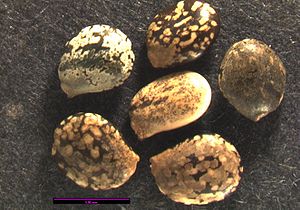Difference between revisions of "Lupinus albicaulis"
| Line 74: | Line 74: | ||
{{Basics}} | {{Basics}} | ||
| + | ===References=== | ||
| + | ---- | ||
| + | <References/> | ||
Revision as of 15:00, 23 April 2012
LUAL3
Contents
Taxonomy
- Kingdom - Plantae – Plants
- Subkingdom - Tracheobionta – Vascular plants
Superdivision - Spermatophyta – Seed plants
- Division - Magnoliophyta – Flowering plants
- Class - Magnoliopsida – Dicotyledons
- Subclass - Rosidae
- Order - Fabales
- Family - Fabaceae – Pea family
- Genus - Lupinus L. – lupine
- Species - Lupinus albicaulis Douglas – sicklekeel lupine
Synonyms
Lupinus albicaulis Dougl. var. albicaulis Lupinus falcifer Nutt. ex Torr. & Gray (pro syn.) Lupinus quercetorum Heller Lupinus wolfianus C.P. Sm.
Plant Description
General:It is a hairy, erect perennial herb often exceeding a meter in height. Leaf: Each palmate leaf is made up of 5 to 10 leaflets each up to 7 centimeters long. The inflorescence is up to 44 centimeters long, bearing whorls of flowers each 1 to 1.6 centimeters long. Flower: The flower is purple to yellowish or whitish in color and has a sickle-shaped keel. Fruit: The fruit is a silky-hairy legume pod up to 5 centimeters long containing several seeds
Bloom Period
May to July [2]
Distribution
Chiefly west of the Cascades in Washington; Washington south to California. May to July [2]
Habitat
Grasslands and prairies from the lowlands to moderate elevations.[2]
Uses
Good for use in soil stabilization in locations of poor soil fertility, and drought, Lupinus albicaulis has the ability to fix nitrogen and grow rapidly.[3]
Propagation
Seed
Abbreviation: LUAL
Seed sample from: 2011
Average Measurement: 5.7 x 4.4 x 2.1
Measurement Range: L: 5 - 6.5, W: 4 - 5, D: 1.5 - 2.5
Features
Color: Seeds are mostly off-white, tan, or gray with darker brown or tan mottling. Speckles tend to be heavier at seed edges leading to a darkened appearance.
Surface: Seeds smooth and glossy with some concave pitting.
Latitudinal Cross Section: elliptical ![]()
Longitudinal Cross Section: elliptical ![]()
Basic Explanations and Assumptions:
The dimensions for the seeds are length x width x depth. The location of the hilum is used as the base of the seed, and the length is measured from hilum to the opposite apex. Where a style is present, the length is measured from the hilum to the bottom of the style. Width is measured at a right angle to the length at the widest part. Depth is measured at a right angle to the intersection of height and width lines.
Measurements included are the mean average for each measurement of ten separate seeds.
All measurements in millimeters unless otherwise noted.

